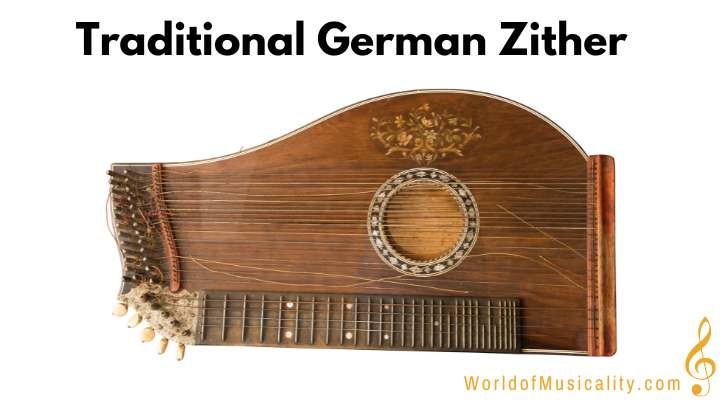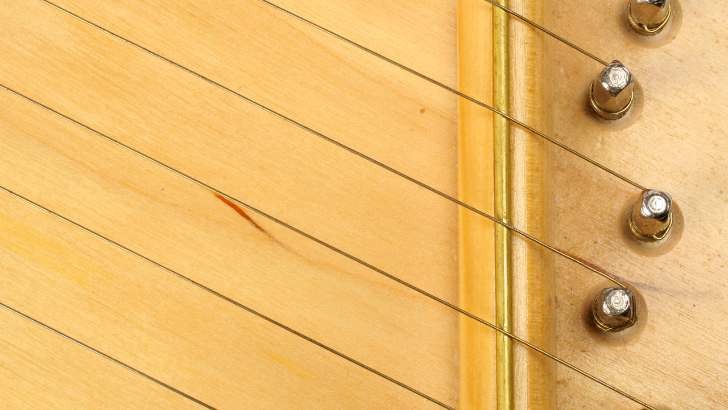Are you curious about musical instruments and looking for a unique stringed instrument? WHAT.EDU.VN is here to help! The zither, with its flat soundbox and numerous strings, offers a captivating blend of melody and harmony. Let’s explore the zither, including its sounds, playing techniques, history, and some famous pieces. Dive in to discover the magic of this enchanting instrument and expand your musical knowledge with information on this chordophone.
1. What is a Zither Instrument?
A zither is a stringed musical instrument characterized by a flat, shallow soundbox over which multiple strings are stretched. Zithers are played by plucking or strumming the strings, often while the instrument rests horizontally on a table or the player’s lap.
The zither family encompasses a diverse range of instruments, each with unique characteristics and playing styles. According to the Hornbostel-Sachs classification system, zithers are categorized as chordophones, instruments that produce sound by vibrating strings. This broad category includes various subtypes, such as the concert zither, Alpine zither, chord zither, and hammered zither, each offering distinct tonal qualities and musical applications.
1.1. Zither Instrument Facts
Here are some interesting facts about the zither:
- Zither players are often called zitherists.
- Types include concert, Alpine, and chord zithers, each with different sound qualities.
- Zithers appear in folk, classical music, contemporary pop, and film scores.
- Concert zithers usually have 29 to 37 strings, blending melody, accompaniment, and bass.
- Concert zithers are about 50 to 60 cm long and weigh 1.5 to 3 kg.
- Zithers are chordophones, producing sound through string vibration.
- Antique or master-crafted zithers can be expensive, costing thousands of dollars.
- The zither’s history dates back centuries in Asia and Europe.
- Zither construction uses woods like spruce, maple, or mahogany.
- Modern zithers can have electronic pickups for amplification.
- Basic zither techniques are accessible to beginners, but mastery requires practice.
2. What Does a Zither Instrument Sound Like?
The zither produces a harmonious and resonant sound, often described as a cross between the delicate tinkling of a piano and the rich, deep tones of a harp. Its sound can be both soothing and vibrant, making it suitable for various musical genres. The video below demonstrates the unique sounds of the instrument.
2.1. Hear What the Zither Sounds Like
[Embedded YouTube Video Here]
3. How to Play the Zither Instrument
The zither is played by strumming or plucking its strings while it lays flat on a table or the player’s lap. This allows for direct interaction with the strings, using fingers, picks, or plectrums to generate sound. This section explores the sound production mechanism, playing techniques, and the versatility of the instrument in creating music.
3.1. Learn How to Play the Zither
The mechanism of sound production involves the vibration of strings stretched over a resonant body. When a string is plucked, it vibrates at a specific frequency, creating sound waves that resonate through the instrument’s body and project into the air.
The zither’s soundboard, typically made of spruce or another resonant wood, amplifies these vibrations, enriching the instrument’s tone and volume. This combination of string vibration and body resonance is crucial for the zither’s distinctive sound.
A player can produce a wide range of sounds from the zither by varying the method of plucking and the strings they choose to play. Specific melody strings, for example, are played with the dominant hand, while the accompanying chords and bass strings, grouped on the opposite side, are played with the other hand. This allows for the simultaneous production of melody and harmony, a feature that gives the zither its full, orchestral sound.
4. What are the Different Types of Zither Instruments to Learn?
There are several types of zithers, each offering a unique playing experience and sound. Exploring these varieties can help enthusiasts find the one that best suits their musical preferences and playing style.
4.1. Concert Zither
A popular model featuring a combination of melody, accompaniment, and bass strings, allowing for complex solo performances. Its versatility makes it suitable for a wide range of musical styles, but it has a steep learning curve due to its complex string arrangement.
4.2. Alpine Zither
Similar to the concert zither but often used in folk music, with a focus on melody strings. Its rich, resonant sound is ideal for traditional and folk music, but it has less versatility in musical genres outside of folk traditions.
4.3. Chord Zither
Features groups of strings tuned to chords, making it easier for beginners to accompany melodies. It is easier to learn for beginners because there is no need for intricate finger placements, but it is limited in terms of musical complexity and solo performance.
4.4. Electric Zither
A modern take on the traditional zither, equipped with electronic pickups for amplification. It can be easily amplified for performances and offers modern sound possibilities, but may require additional equipment and setup.
4.5. Hammered Zither
Played with small hammers striking the strings, offering a unique timbre. Its distinctive sound allows for rapid, percussive playing styles, but requires coordination for hammer use and a different playing technique compared to plucked zithers.
5. What are the Musical Origins of the Zither?
The zither’s name traces back to the Greek word “kithara,” an ancient instrument similar to a lyre. Through linguistic evolution, “kithara” transformed across centuries and cultures, becoming “cithara” in Latin, then transitioning into various European languages. In German, it morphed into “zither,” a term now used globally.
5.1. Instrument History
From its ancient origins, the zither has journeyed through Asia, arriving in Europe by the Middle Ages. Its evolution includes various forms and uses across different cultures. The table below shows the long historical development of the zither.
| Time Period | Zither Development |
|---|---|
| Ancient Times | Early forms resembling zithers appear in Asia and Europe, played with fingers or plectrums. |
| Middle Ages | Zithers gain popularity in Europe, with variations such as the Scheitholt. |
| 19th Century | The concert zither evolves in German-speaking countries, featuring a more refined structure. |
| Early 20th Century | Zither’s popularity spreads, influencing music across genres and cultures. |
| Late 20th to 21st Century | Modern zithers incorporate electronic amplification, expanding their use in various musical styles. |




Alt Text: Musician playing a traditional German zither, highlighting the instrument’s flat soundbox and multiple strings.
6. What is the Zither Instrument Description?
The zither’s construction blends traditional woodworking with acoustics. The primary components include the body, strings, tuning pegs, fretboard, bridge, and plectrum.
- Body: The body forms the foundation of the zither, acting as the main resonating chamber. Crafted from woods like spruce, maple, or mahogany, the choice of wood affects the instrument’s tone. Spruce, known for its resonance, is often used for the soundboard, while maple and mahogany are preferred for the back and sides.
- Strings: The zither’s strings, made from steel or nylon, stretch across the body, with their number and arrangement varying among different types of zithers. Steel strings offer a brighter sound and are common in concert and Alpine zithers, while nylon strings produce a softer tone and are used in practice zithers for beginners.
- Tuning Pegs: Made from metal or wood, tuning pegs allow for the adjustment of string tension, tuning the instrument. Located on one side of the instrument’s body, they are integral for maintaining the zither’s sound quality.
- Fretboard: Present in some zither variations, the fretboard features metal frets that divide the strings into specific pitches. Made from hardwoods like rosewood or ebony, the fretboard enables players to produce a range of notes and chords by shortening the vibrating length of the strings.
- Bridge: The bridge, typically made of hardwood, supports the strings and transmits their vibrations to the body, enhancing the instrument’s sound. Its position and material are crucial for the zither’s tonal characteristics, with harder woods contributing to a clearer sound.
- Plectrum: Often used to pluck the strings, the plectrum can be made from plastic, metal, or tortoiseshell. It allows for precise control over the strings, enabling a variety of playing techniques and dynamics.
Alt Text: Close-up of zither strings and tuning pegs, showcasing the instrument’s intricate string arrangement and tuning mechanism.
7. Who are Some Famous Zither Players?
The zither has been mastered by many, but only a few musicians have elevated its status on the global stage. These artists have showcased the instrument’s potential and contributed to its evolution.
7.1. Anton Karas
An Austrian musician, Karas is famous for his performance of “The Third Man Theme” for the 1949 film “The Third Man.” His unique playing style and the song’s success made the zither synonymous with post-war Viennese culture.
[Embedded YouTube Video Here]
7.2. Ruth Welcome
An American zitherist, popularized the instrument in the United States during the 1950s and 1960s. Her albums of zither music crossed classical and popular boundaries, bringing the sweet sounds of the zither to a broad audience.
7.3. Johann Petzmayer
Hailing from Austria, Petzmayer was pivotal in the mid-20th century, known for his performances and for teaching the zither. His contribution to the Viennese music scene helped sustain the zither’s popularity during a crucial period.
Alt Text: Johann Petzmayer, an Austrian zither player, holding a zither, illustrating his significant role in the instrument’s history and Viennese music.
7.4. Shirley Abicair
An Australian-born musician and television personality, introduced the zither to a wider, international audience in the 1950s and 1960s. Her engaging performances on the zither, combined with her singing, made her a beloved figure.
7.5. Takashi Ochi
A Japanese zither player, made significant contributions to the European zither scene after moving to Germany. His expertise and performances have been critical in bridging cultural gaps and showcasing the zither’s universality.
Alt Text: Takashi Ochi, a Japanese zither player, performing on a concert zither, demonstrating his contribution to the instrument’s global recognition.
8. What is Some Prominent Traditional Zither Music?
The zither occupies a unique place in folk music genres and cultures with its rich, melodious sound. These five traditional tunes and compositions highlight the zither’s capabilities and its role in music history.
8.1. “Zillertaler Hochzeitsmarsch” (Traditional Austrian)
This Austrian wedding march is a staple in the repertoire of zither players, showcasing the instrument’s ability to convey both joy and solemnity. Its exact date of composition is unknown, reflecting its roots in Austrian folk tradition.
8.2. “Bavarian Zither Melody” (Traditional Bavarian)
A quintessential piece that embodies the beauty and cultural richness of Bavaria. This melody, often passed down through generations, highlights the zither’s role in celebrating and preserving regional identity.
8.3. “Heimatliche Klänge” by Josef Friedrich Doppelbauer (1950s)
Doppelbauer, an Austrian composer, contributed to the zither’s classical repertoire with this piece, translating to “Sounds of Home.” It evokes a sense of nostalgia and deep connection to the Alpine landscapes.
8.4. “Alpine Echoes” by Ruth Welcome (1960s)
This composition by American zitherist Ruth Welcome captures the essence of alpine music and demonstrates the zither’s adaptability to various styles. Her work significantly contributed to the popularity of the zither in the United States.
8.5. “Tiroler Zithermarsch” (Traditional Tyrolean)
This lively march is a traditional tune from the Tyrol region of Austria, embodying the spirit and pride of the Tyrolean people. Characterized by its energetic rhythm, it is a testament to the zither’s versatility, capable of performing both tender melodies and spirited compositions.
9. What Instruments are Similar to a Zither?
The zither has several relatives in the world of musical instruments which share certain characteristics, yet possess their own unique features. This exploration of five instruments closely related to the zither offers a glimpse into the diversity of the stringed instrument family.
9.1. Dulcimer
The dulcimer, particularly the Appalachian or mountain dulcimer, is a stringed instrument that hails from the United States. Played by strumming or plucking the strings with a pick while it rests on the player’s lap, the dulcimer has a fretted fingerboard, allowing for a variety of melodies. Its sweet, melodic sound makes it popular in folk and traditional music.
9.2. Autoharp
The autoharp is a string instrument with a series of chord bars attached to dampers, which, when pressed, mute all strings except those that form the desired chord. Originating in the late 19th century, the autoharp is played by strumming the strings while pressing the chord bars, facilitating easy accompaniment to singing.
9.3. Guzheng
The guzheng, or zheng, is a Chinese plucked zither with a history dating back over 2,500 years. It typically has 21 strings and movable bridges, allowing for a wide range of pitches. Players use techniques such as plucking, strumming, and bending the strings to create its distinctive, flowing sound, integral to Chinese traditional music.
9.4. Koto
The koto is a traditional Japanese stringed instrument, also a type of zither, with 13 strings that are plucked using small picks worn on the fingers. It has a long, rectangular body and movable bridges to adjust the pitch of each string. The koto produces a serene and expressive sound, playing a key role in Japanese classical and contemporary music.
9.5. Kanun
The kanun is a plucked zither found in Middle Eastern music, known for its trapezoidal shape and a range of 26 to 33 courses of strings. Each course has three strings, and the kanun is played with small, metal-tipped picks attached to the fingers. Its intricate ornamentation and the ability to produce microtonal variations make it a central instrument in traditional Arabic, Turkish, and Persian music.
10. Frequently Asked Questions (FAQ) About Zithers
| Question | Answer |
|---|---|
| What is the difference between a zither and a harp? | A zither has strings stretched across a flat soundbox and is played horizontally, while a harp has strings arranged vertically in a frame. |
| How many strings does a typical zither have? | A concert zither typically has between 29 and 37 strings, combining melody, accompaniment, and bass strings. |
| What type of music is the zither used in? | The zither is used in various genres, including folk, classical, and film music. It is particularly prominent in Austrian and Bavarian folk music. |
| Is the zither difficult to learn? | Learning basic zither techniques is accessible to beginners, but mastering the instrument requires significant practice and skill, especially for complex pieces. |
| What are the main types of zithers? | The main types include the concert zither, Alpine zither, chord zither, electric zither, and hammered zither, each offering distinct tonal qualities and playing styles. |
| How is the zither tuned? | The zither is tuned by adjusting the tension of each string using tuning pegs. The specific tuning varies depending on the type of zither and the musical style. |
| What materials are used to make a zither? | Zithers are typically made from woods like spruce, maple, and mahogany. The strings are made from steel or nylon, and the tuning pegs are made from metal or wood. |
| Who is a famous zither player? | Anton Karas is perhaps the most famous zither player, known for his performance of “The Third Man Theme.” |
| What is the role of the bridge on a zither? | The bridge supports the strings and transmits their vibrations to the body, enhancing the instrument’s sound. Its position and material are crucial for the zither’s tonal characteristics. |
| Where does the name ‘zither’ come from? | The name “zither” traces back to the Greek word “kithara,” an ancient instrument similar to a lyre. It evolved through Latin (“cithara”) and German before becoming the term used globally today. |
| Are there any modern adaptations of the zither? | Yes, modern zithers include electric zithers, which are equipped with electronic pickups for amplification. This allows them to be used in contemporary music styles and larger venues. |
| How do you care for and maintain a zither? | To care for a zither, keep it in a stable environment with controlled humidity and temperature. Regularly clean the strings and body, and have it professionally serviced to maintain its sound quality and structural integrity. |
| Can you play chords on a zither? | Yes, you can play chords on a zither. Some zithers, like the chord zither, are specifically designed for playing chords, with groups of strings tuned to common chord voicings. |
| What is the difference between a zither and a guzheng? | While both are types of zithers, the guzheng is a Chinese instrument with a longer body and more strings (typically 21) than many Western zithers. The guzheng also uses movable bridges to adjust the pitch of each string, allowing for a wider range of tonal possibilities and microtonal variations. |
| Are zithers used in any specific cultural traditions? | Zithers are prominently featured in Austrian and Bavarian folk music traditions, often used in festive occasions, weddings, and local celebrations. They are also used in some Asian cultures, particularly in the form of instruments like the guzheng and koto, which have their own rich cultural contexts and musical practices. |
11. Still Have Questions About the Zither? Ask WHAT.EDU.VN!
Finding reliable information about musical instruments can be challenging. Are you struggling to find quick, free answers to your questions? Do you feel lost trying to navigate complex musical concepts? WHAT.EDU.VN offers a platform where you can ask any question and receive clear, accurate answers from knowledgeable experts. Don’t let your curiosity fade – get the answers you need today!
Visit WHAT.EDU.VN now to ask your questions and connect with a community eager to share their expertise. Whether you’re curious about the zither or any other topic, what.edu.vn is here to help. Contact us at 888 Question City Plaza, Seattle, WA 98101, United States, or via WhatsApp at +1 (206) 555-7890.
This is the end of the document.